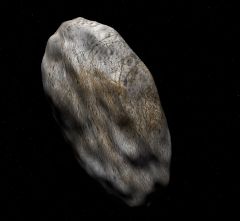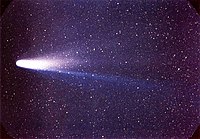Difference between revisions of "Halley"
(Earth article.) |
(→Halley in Orbiter: Added title to table.) |
||
| (10 intermediate revisions by the same user not shown) | |||
| Line 1: | Line 1: | ||
| − | {| cellpadding="2" cellspacing="0" style="margin:25px 0 0 10px; border:3px solid lightsteelblue;width:250px; font-size:90%; font-family:'Arial','Helvetica'; float: right; clear: right;"Template in Orbiter | + | {| cellpadding="2" cellspacing="0" style="margin:25px 0 0 10px; border:3px solid lightsteelblue;width:250px; font-size:90%; font-family:'Arial','Helvetica'; float: right; clear: right;"Template in Orbiter" |
| − | !bgcolor="lightsteelblue" colspan="2" align="center" | | + | !bgcolor="lightsteelblue" colspan="2" align="center" |Halley |
|- | |- | ||
| − | |colspan="2" align="center"|[[Image: | + | |colspan="2" align="center"|[[Image:HalleyScrnshot.jpg|240px]] |
|- | |- | ||
| − | |colspan="2" align="center"|''' | + | |colspan="2" align="center"|'''Halley in Orbiter 2016 with D3D9 client''' |
|- | |- | ||
!bgcolor="lightsteelblue" colspan="2"|Designation | !bgcolor="lightsteelblue" colspan="2"|Designation | ||
|- | |- | ||
| − | |Name||align="right"| | + | |Name||align="right"|Halley |
|- | |- | ||
| − | |width="30%"|Reference body||align="right" width="30%"|Sun | + | |width="30%"|Reference body||align="right" width="30%"|[[Sun]] |
| − | |||
| − | |||
|- | |- | ||
!bgcolor="lightsteelblue" colspan="2"|Planetary mean orbits | !bgcolor="lightsteelblue" colspan="2"|Planetary mean orbits | ||
|- | |- | ||
| − | |width="30%"|Epoch||align="right" width="50%"| | + | |width="30%"|Epoch||align="right" width="50%"|2006 |
| − | |||
| − | |||
| − | |||
| − | |||
| − | |||
| − | |||
| − | |||
| − | |||
| − | |||
| − | |||
| − | |||
| − | |||
|- | |- | ||
| − | + | |width="30%"|Semimajor axis (a)||align="right" width="50%"|2669601650361.16 m | |
|- | |- | ||
| − | |width="30%"| | + | |width="30%"|Eccentricity (e)||align="right" width="30%"|0.967449497943645 |
|- | |- | ||
| − | |width="30%"| | + | |width="30%"|Inclination (i)||align="right" width="30%"|162.2922643° <br> (2.83253436266766 radian) |
|- | |- | ||
| − | |width="30%"| | + | |width="30%"|Longitude of the ascending node (LAN, ☊)||align="right" width="30%"|58.2997774° <br> (1.01752306877974 radian) |
|- | |- | ||
| − | |width="30%"|Longitude of | + | |width="30%"|Longitude of periapsis (ϖ)||align="right" width="30%"|169.4792496° <br> (2.95797092009003 radian) |
|- | |- | ||
| − | + | |width="30%"|Mean longitude (L)||align="right" width="30%"|264.6340534° <br> (4.61873554527679 radian) | |
| − | |||
| − | |width="30%"|Mean longitude (L)||align="right" width="30%"| | ||
|- | |- | ||
!bgcolor="lightsteelblue" colspan="2"|Selected physical parameters | !bgcolor="lightsteelblue" colspan="2"|Selected physical parameters | ||
|- | |- | ||
| − | |width="30%"|Mean radius||align="right" width="30%"| | + | |width="30%"|Mean radius||align="right" width="30%"|5500 km |
| − | |||
| − | |||
| − | |||
| − | |||
| − | |||
| − | |||
| − | |||
| − | |||
| − | |||
| − | |||
| − | |||
| − | |||
| − | |||
| − | |||
| − | |||
| − | |||
| − | |||
| − | |||
|- | |- | ||
| − | |width="30%"| | + | |width="30%"|Mass||align="right" width="30%"|1×10<sup>14</sup> kg |
|- | |- | ||
!bgcolor="lightsteelblue" colspan="2"|Rotation elements | !bgcolor="lightsteelblue" colspan="2"|Rotation elements | ||
|- | |- | ||
| − | |width="30%"| | + | |width="30%"|SidRotPeriod||align="right" width="30%"|187200 seconds (52 hours) |
|- | |- | ||
| − | |width="30%"| | + | |width="30%"|SidRotOffset||align="right" width="30%"|0 |
|- | |- | ||
| − | |width="30%"|Obliqutiy | + | |width="30%"|Obliqutiy||align="right" width="30%"|0 |
|- | |- | ||
| − | |width="30%"| | + | |width="30%"|LAN||align="right" width="30%"|0 |
|- | |- | ||
| − | + | |width="30%"|Note||align="right" width="30%"|*Elements given are from Halley.cfg (Halley.zip) | |
| − | + | |} | |
| − | |width="30%"| | + | |
| + | {{Addon | ||
| + | |1=[https://www.orbiter-forum.com/resources/halleys-comet-nucleus.1491/ Halley's Comet Nucleus] | ||
| + | |2=[[List of add-ons by Nighthawke|Nighthawke]] | ||
| + | |3=2004-11-22 | ||
| + | |4= | ||
| + | }} | ||
| + | |||
| + | '''Halley's Comet''', also referred to as 1P/Halley, is a short period comet appearing in the skies every 72 to 80 years, last seen in 1986 and the next will be in 2061. Named after [[w:Edmond Halley|Edmond Halley]] who was the first to recognize it as a recurring comet although it has been seen since ancient times. | ||
| + | |||
| + | == Halley in Orbiter == | ||
| + | Halley was introduced to [[Orbiter]] as an add-on in 2004. Since Orbiter was not designed to show a comet's tails, the add-on depicts it as a rugby ball shaped body much like an asteroid. | ||
| + | Halley orbits the [[Sun]] in a very elliptical orbit, moving retrograde to the Sun, unlike the planets which move prograde, or counter-clockwise looking from the north of the [[Solar System]]. [[periapsis|Periapsis]] takes Halley to between the orbits of [[Mercury]] and [[Venus]], and at [[apoapsis]] it is beyond that of [[Neptune]]. | ||
| + | |||
| + | Note that when landed on Halley near the apoapsis, Halley provides only about 1% of the total gravity, the other 99% by the Sun, but, near apoapsis, Halley provides 98% of the gravity, the Sun, only about 2%. It may be difficult to stay landed near Halley's periapsis. The sphere of influence near apoapsis is about 37 km from the center, and near periapsis, the SOI is right about the surface. | ||
| + | |||
| + | It can be difficult to visit Halley as when it is near apoapsis, Halley is traveling at about 900 m/s, but it's 35 AU from the Sun. Near Periapsis, it's about 0.5 AU from the Sun, but it's traveling almost 55000 m/s. | ||
| + | |||
| + | It should also be noted that when landing on Halley that the visual surfaces are well below the hard radius (5500 meters), which is not visible, so instrument landing with HUD in surface is recommended. | ||
| + | |||
| + | {| class="wikitable" style="text-align: center" | ||
|- | |- | ||
| − | | | + | |colspan="8"|<center>'''Add-ons which include Halley'''</center> |
|- | |- | ||
| − | + | !Add-on!!Source!!Version!!Author!!Type!!Release Date!!Compatibility!!Wiki article | |
|- | |- | ||
| − | | | + | |[https://www.orbiter-forum.com/resources/halleys-comet-nucleus.1491/ Halley's Comet Nucleus]||O-F Resources||2004-11-22||Nighthawke||Scenery||22 November 2004|||| |
| − | |- | ||
| − | |||
| − | | | ||
| − | |||
| − | | | ||
| − | | | ||
|} | |} | ||
| − | |||
| − | + | == See also == | |
| + | [[w:Halley's Comet|Halley's Comet]] at [[w:Wikipedia|Wikipedia]] | ||
| + | |||
| + | == Gallery == | ||
| + | <gallery widths="200" heights="200"> | ||
| + | Lspn comet halley.jpg|<center>Comet 1P/Halley as it appeared from Earth on 8 March 1986</center> | ||
| + | Comet Halley close up-cropped.jpg|<center>The nucleus of Halley as seen by the [[w:Giotto (spacecraft)|Giotto]] spacecraft in 1986</center> | ||
| + | Halley's Comet animation.gif|<center>Animation of Halley's orbit<br>The outermost planet is Neptune</center> | ||
| + | Animation of 1P/Halley orbit - 1986 apparition.gif|<center>Orbiter path of Halley during the 1986 apparition as compared to Earth</center> | ||
| + | </gallery> | ||
| − | + | {{SolarSystem}} | |
| − | |||
| − | + | [[Category:Articles]] | |
| + | [[Category:Celestial bodies]] | ||
| + | [[Category:Comets]] | ||
Revision as of 11:53, 1 August 2024
| Halley | |
|---|---|

| |
| Halley in Orbiter 2016 with D3D9 client | |
| Designation | |
| Name | Halley |
| Reference body | Sun |
| Planetary mean orbits | |
| Epoch | 2006 |
| Semimajor axis (a) | 2669601650361.16 m |
| Eccentricity (e) | 0.967449497943645 |
| Inclination (i) | 162.2922643° (2.83253436266766 radian) |
| Longitude of the ascending node (LAN, ☊) | 58.2997774° (1.01752306877974 radian) |
| Longitude of periapsis (ϖ) | 169.4792496° (2.95797092009003 radian) |
| Mean longitude (L) | 264.6340534° (4.61873554527679 radian) |
| Selected physical parameters | |
| Mean radius | 5500 km |
| Mass | 1×1014 kg |
| Rotation elements | |
| SidRotPeriod | 187200 seconds (52 hours) |
| SidRotOffset | 0 |
| Obliqutiy | 0 |
| LAN | 0 |
| Note | *Elements given are from Halley.cfg (Halley.zip) |
|
Project home: Halley's Comet Nucleus |
Halley's Comet, also referred to as 1P/Halley, is a short period comet appearing in the skies every 72 to 80 years, last seen in 1986 and the next will be in 2061. Named after Edmond Halley who was the first to recognize it as a recurring comet although it has been seen since ancient times.
Halley in Orbiter
Halley was introduced to Orbiter as an add-on in 2004. Since Orbiter was not designed to show a comet's tails, the add-on depicts it as a rugby ball shaped body much like an asteroid. Halley orbits the Sun in a very elliptical orbit, moving retrograde to the Sun, unlike the planets which move prograde, or counter-clockwise looking from the north of the Solar System. Periapsis takes Halley to between the orbits of Mercury and Venus, and at apoapsis it is beyond that of Neptune.
Note that when landed on Halley near the apoapsis, Halley provides only about 1% of the total gravity, the other 99% by the Sun, but, near apoapsis, Halley provides 98% of the gravity, the Sun, only about 2%. It may be difficult to stay landed near Halley's periapsis. The sphere of influence near apoapsis is about 37 km from the center, and near periapsis, the SOI is right about the surface.
It can be difficult to visit Halley as when it is near apoapsis, Halley is traveling at about 900 m/s, but it's 35 AU from the Sun. Near Periapsis, it's about 0.5 AU from the Sun, but it's traveling almost 55000 m/s.
It should also be noted that when landing on Halley that the visual surfaces are well below the hard radius (5500 meters), which is not visible, so instrument landing with HUD in surface is recommended.
| Add-on | Source | Version | Author | Type | Release Date | Compatibility | Wiki article |
|---|---|---|---|---|---|---|---|
| Halley's Comet Nucleus | O-F Resources | 2004-11-22 | Nighthawke | Scenery | 22 November 2004 | ||
See also
Gallery
The nucleus of Halley as seen by the Giotto spacecraft in 1986
| edit The Solar System | |
|---|---|
| Central star |
Sun (Sol) |
| Planets |
Mercury - Venus - Earth - Mars - Jupiter - Saturn - Uranus - Neptune |
| Natural satellites |
Moon - Phobos - Deimos - Io - Europa - Ganymede - Titan - more... |
| Add-ons |
Planets - Dwarf Planets - Small objects - Natural satellites - Alternative star systems |



